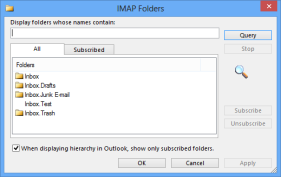Synching issues in Outlook 2013
Synching issues in Outlook 2013
It seems like the latest updates for Outlook completely broke IMAP account in Outlook 2013. For example, the inbox folder remains empty with the message “We didn’t find anything to show here”. In other folders, few e-mails can’t be progress or eliminated until and unless you do not sync to the server. It appears that IMAP in Outlook 2013 is only getting nasty, when will it get superior and troubleshoot current issues. Moreover, the November update for Outlook 2013 (KB2837618) troubleshoots a complete lot of IMAP troubles and is highly approved. Amongst alternatives, the renovate makes convinced that IMAP accounts will not frequently entirely resynch folders, will not create carbon copies of default folders, will more accurately map the special server folders and produce it less credible that folders will get marked as “This computer only”.
Nevertheless, it is now also more crucial than ever to accurately set the Root Folder Path for your e-mailbox when your IMAP server needed it. Regrettably, Outlook doesn’t discover this automatically but you require setting it manually. If you do not implement this, your Inbox could remain vacant and other folders might not sync or reflect up at all and move, copy and delete actions could consequence in permission errors. Some of the important steps are –
Root your mailbox
Few IMAP servers branch of all your folders from the Inbox folder. In that situation, you will require to set the “Root folder path” property in your account formation. Searching out whether or not this is needed for you is quite simple. Select the Folder tab in Outlook, have a click on the button IMAP Folders and then click the Enquiry button. If all folders begin with a customary name followed by a dot, then that first fragment is your root name.
How to set the root folder path for your IMAP account:
- File-> Account Settings-> Account Settings.
- Double click on your IMAP account.
- Button: More Options
- Tab: Advanced
- Option: Root folder path
- Usually setting this to “Inbox” will do the trick.
- OK yourself out all of the opened dialogs.
Subscribe to folders
Once you have accurately set the root folder path for your IMAP mailbox, you may be misplaces some subfolders or discover that folders aren’t synching. To resolve this, go back to the Folder tab, click on the Outlook Folders button and press the Enquiry button. Make assure that you are pledged to the folders which you desire to see and sync in Outlook. In rare situations, you might still experience some troubles with synching. In that situation, you can try weaken the option “When displaying pecking in Outlook, exhibit only subscribed folders.”
Check your cache retention settings
Determining on the size of your hard disk or SSD in your PC, your Offline Settings might be set to only stock upto 1 month, 3 months, 12 month worth of emails on your local disk. If you have got sufficient space on your disk and desire to cache more emails regionally, you can place the sync slider in the following way:
File-> Account Settings-> Account Settings…-> double click on your IMAP account
If it fails: recreate the IMAP account in Outlook
If the above steps didn’t generate any results, you might desire to begin fresh by eliminating your IMAP account from Outlook and then attaching it again. You can do this via:
File-> Account Settings-> Account Settings…
Keep in mind that you will first require to export the folders which are highlighted with “This computer only” to a pst-file. Don’t ignore your Calendar and Contacts folders!
File-> Open & Export-> Import/Export-> Export to a file-> Outlook Data File (.pst)
If you are still having troubles then and want to trade-off the update for now, you can implement this via Control Panel when you are utilizing the msi-installer or through a command line when you are utilizing an Office 365 installation of Office 2013.
Open issues
While the upgrade fixed a complete lot of IMAP troubles, IMAP in Outlook still isn’t accurate (if there is similar a thing when it comes to IMAP in general) and there are a couple of things to be taken care of.
Languages issues
If you are running with an IMAP server which is utilizing names for special folders in a language other than your local language of Outlook, these special folder might not be identified in Outlook and local “This computer only” folders might be generated. For example, an English version of Outlook might not accurately map the Sent Items folder to the “Verzonden items” folder located on a Dutch IMAP. Regrettably, it is not feasible to manually map these special folders in Outlook to the special folders on the server in situation when Outlook fails to implement this automatically. To resolve this, rename the folders on the IMAP servers in order to contest the language of your earlier installed version of Outlook.
Ost-file isn’t recoverable
Another crucial thing to keep in mind is that the ost-file of an IMAP account isn’t amendable without utilizing (expensive) 3rd party tools; you can’t re-utilize the ost-file when you again create the account or progress it to another PC or computer! This signifies that all the folders which have “This computer only” behind them will be missing if you do not export them. This also incorporates your Calendar and Contacts folder when they are reserved within the ost-file of your IMAP account. To stop this, you can alter your configuration of Outlook 2013 in such a manner that it behaves like Outlook 2010 and previous where the Calendar and Contacts folder were reserved in a separate pst-file and thus completely recoverable.



[…] Tips To Enable Auto Replies In Outlook 2013 […]